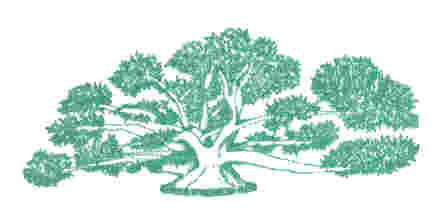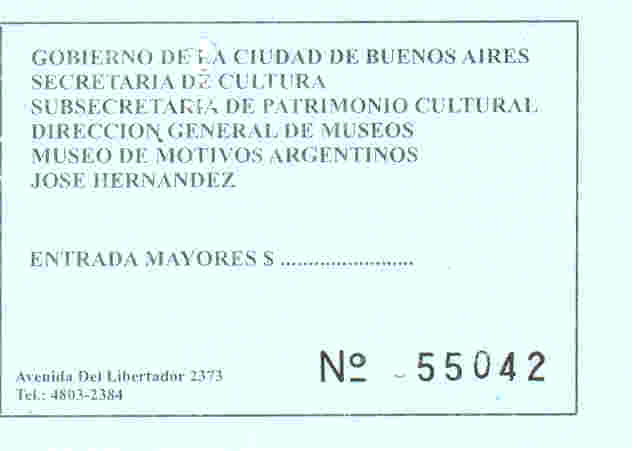Day 4B - Recoleta
Recoleta is one of the city's premier addresses. It became popular in the 1870s, when the city's elite moved here to escape the yellow fever epidemic that engrossed the southern residential areas. Most visitors come to Recoleta to view the famous cemetery, which is the final resting place for many of the country's most famous deceased.
Still technically in the barrio of Palermo, but on the border with Recoleta, is the Parque de las Heras. The park is named for General de Heras, who was a hero of the Argentine independence movement. On this Saturday afternoon, the park was filled with sun worshippers. On the northern edge of the park is the Museo de Motivos Argentinos José Hernández. The museum celebrates one of the country's most famous icons, the gaucho. The museum is housed in two buildings that surround a shaded courtyard. The front building displays pictures and gaucho items, including beautiful silver knives and belts. The second building has two floors of display space. On the first floor, beautiful weavings were being displayed. On the second floor, traditional arts by native American populations were displayed. Oddly enough, no items from the United States were displayed.
A couple of blocks southwest of the park is the Alto Palermo shopping center. This is one of the city's older shopping malls, and it is popular with the younger crowd. I was visiting the city just before the beginning of the Christmas shopping season, so the interiors was decorated with Christmas trees and other festive ornaments. Because I visited on a Saturday, the mall was crowded with all types of people - from obnoxious teenagers to slow-moving senior citizens.
|
|
|
| The façade of the front building of the Museo de Motives Argentinos José Hernández | Entrance ticket for the museum |
|
|
|
| The façade of the Alto Palermo shopping center | The beautiful and tree-shaded Parque de Las Heras |
From the shopping center, I headed almost due east deep into the Recoleta barrio. It was a hot afternoon and I was tried, so I didn't spend much time walking around the barrio. Since my hotel was in the neighborhood, I had walked many of the main streets already. In addition, I had spent a considerable amount of time on Avenida Santa Fe, as my favorite café, Babieca, was on this street. I spent many evenings in this coffeehouse, watching the world pass by.
I spent most of this particular afternoon in the northeast corner of the barrio, around the Cementario de la Recoleta. Death is a celebrated event in Argentina, and this cemetery is the epitome of grandiose burial in the country. Many of the city's most prominent families bury their dead here; the most famous resident is Eva de Péron, the former first lady of the country. Opened in 1822, the cemetery was designed by Frenchman Prospero Catelin. Unfortunately, the cemetary was closed when I visited, so I was not able to wander among the beautiful granite, marble and bronze mausoleums.
Next to the cemetery's entrance is the Basílica Nuestra del Pilar. Founded as a Jesuit church and consecrated in 1732, it is the favoirte church for the weddings of the city's elite. The interior is decorated with sky-blue Pas-de-Calais ceramic tiles, which is similar to those found in many colonial churches in the provinces. During my visit, there was a number of vendors in the courtyard, selling various items of bric-à-brac.
|
|
|
| The entrance to the Cementario de la Recoleta | The façade of the Basílica Nuestra del Pilar |
Just south of the cemetery is the Buenos Aires Design, a shopping mall devoted to interior design and home renovation. I walked through the mall, and wasn't impressed with the selection. There was one poster store, which sold some interesting works. Most of the other stores were dedicated to furniture or kitchen appliances.
Also in the same area are two impressive statues. One, located in Plaza Indendente Alvear, is dedicated to Carlos María de Alvear, who, according to the Time Out guide, was "... an officer who created the horseguards regiment in 1812 with San Martín, and was the first in a line of Alvears who became important figures in the city's history" (Time Out, 91). Two sculptors contributed to this work of art: French sculptor Emile-Antoine Bourdelle created the equestrian statue, while eminent Argentine sculptor Alejandro Bustillo fashioned the large granite base. The statue commemorates the victory of the combined Argentine and Uruguayan forces over their Brazilian foes in the battle at Ituzaingó. This statue now stands in the middle of a roundabout, making it difficult to access. I had to dodge rapidly moving cars to it. The second statue was unmarked, and located to the southeast of the aforementioned statue.
Also to the south of the Plaza Indendente Alvear is the Palais de Glace. Built in the belle epoque style, this building has housed an ice-rink, a ballroom and a tango studio. As the latter, it made tango popular in the 1920s with the country's middle class. Now, it houses the Sala Nacionales de Cultura, which hosts rotating art exhibits. During my visit, a exhibit of Raul Soldi's work was occurring. I decided to walk through this exhibit, mainly to escape the hot afternoon sun. It was a worthwhile endeavor, as my body temperature returned to normal and I enjoyed viewing the artwork.
|
|
|
| Carlos María de Alvear rides about his horse in this Recoleta statue | An anonymous statue of various angels and heavenly souls |
|
|
|
| The façade of Buenos Aires Design. Notice the Hard Rock Café on the second floor | The Palais de Glace, which was hosting an exhibit of Raul Soldi's work |
The final stop of the day was the Museo Nacional de Bellas Artes, the country's repository of fine art. The building was designed originally as pump house for the city's water system, but was converted into a museum in 1933. The European collection is housed on the first floor, which included many Impressionist works. The second floor was a special exhibition space, which was hosting a biennial display of local artists. I found the quality of the museum pieces to be average. I did return the next day to purchase two replicas of pre-Colombian artifacts.
|
|
|
| The façade of the the Museo Nactional de Bellas Artes. | I bought these pieces at the museum's bookstore. They are replicas of pre-Colombian artifacts found in Argentina. |
 On Saturday evening, I had dinner at
Munich
restaurant, which the guide books had touted as a top-notch steak place. I
sat at a table by myself and rearranged my schedule for the next day. The
meal consisted of a mixed salad, a steak known as "baby beef", ½
bottle of Malbec red wine and dessert. It was average quality, so I wouldn't recommend a
special trip to this restaurant. After dinner, I returned to the Babieca
Café to have dessert and tea. On this evening, I sat at a table on
the side of the restaurant, which gave me a better view of the people chatting
and passing by. Unfortunately, I did not make it out to the local bars
this night. I fell asleep in my hotel room; the rest was probably better
for me.
On Saturday evening, I had dinner at
Munich
restaurant, which the guide books had touted as a top-notch steak place. I
sat at a table by myself and rearranged my schedule for the next day. The
meal consisted of a mixed salad, a steak known as "baby beef", ½
bottle of Malbec red wine and dessert. It was average quality, so I wouldn't recommend a
special trip to this restaurant. After dinner, I returned to the Babieca
Café to have dessert and tea. On this evening, I sat at a table on
the side of the restaurant, which gave me a better view of the people chatting
and passing by. Unfortunately, I did not make it out to the local bars
this night. I fell asleep in my hotel room; the rest was probably better
for me.
Proceed to Day
5 or return to the main Argentina page
